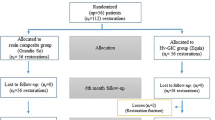Abstract
The purpose of this study is to compare success rates of dual-viscosity impressions for two types of mixing techniques of the polyether elastomeric impression material. Additionally, influencing parameters on the success rates should be evaluated. The expectation was that there would be no difference between the success rates for the two mixing techniques. Two centres enrolled 290 subjects (727 teeth) into the trial. Patients were randomized for the two types of mixing techniques. One step, dual-viscosity impressions were made with either statically mixed Impregum Soft tray material (SAM) or dynamically mixed Impregum Penta H DuoSoft (DMM). Low viscosity Impregum Garant L DuoSoft was used for both groups. Gingival displacement involved the use of two braided cords. Full-arch trays were used exclusively. Both critical defects and operator errors were assessed for the first impression taken by trained dentists. The primary outcome was impression success. For comparison of the two mixing techniques, the odds ratio for success and the corresponding one-sided 95% confidence interval was calculated by a logistic regression model. To account for the dependence between several teeth within one patient, the method of general estimating equations was used. The overall impression success rate was 35.4%. Both mixing techniques showed equal success rates indicated by an OR of 1.0 and a lower limit of the one-sided 95% confidence interval of 0.71. Using this result to develop the corresponding interval for the difference, it could be shown that the success rate using SAM was at most 8.2% lower than that when using DMM with a probability of 95%. Multivariate logistic regression analysis of other potential influencing factors showed position of finish line (p = 0.008, supra compared to mixed), blood coagulation disorder (p = 0.021) and the level of training of the clinician (student vs dentist, p=0.008) to have an independent influence on the success rate. Dynamic mechanical mixing and the new static mixing of polyether tray material showed nearly equal success rates in the study even though success rates were comparatively low (DMM, 35.3%; SAM, 35.4%).



Similar content being viewed by others
References
Stewardson DA (2005) Trends in indirect dentistry: 5. Impression materials and techniques. Dent Update; 32: 374–376, 379–380, 382–374
Michalakis KX, Bakopoulou A, Hirayama H, Garefis DP, Garefis PD (2007) Pre- and post-set hydrophilicity of elastomeric impression materials. J Prosthodont 16:238–248
Stober T, Johnson GH, Schmitter M (2010) Accuracy of the newly formulated vinyl siloxanether elastomeric impression material. J Prosthet Dent 103:228–239
Johnson GH, Mancl LA, Schwedhelm ER, Verhoef DR, Lepe X (2010) Clinical trial investigating success rates for polyether and vinyl polysiloxane impressions made with full-arch and dual-arch plastic trays. J Prosthet Dent 103:13–22
Stackhouse JA Jr (1983) Voids in a mixed elastomeric impression material. J Prosthet Dent 50:762–766
Keck SC (1985) Automixing: a new concept in elastomeric impression material delivery systems. J Prosthet Dent 54:479–483
Powers J, Sakaguchi R (2006) Craig’s restorative dental materials. Elsevier, St. Louis
Kugel G, Swift EJ, Jr., Sorensen JA, Tucker JH, Dunne JT, Jr. (1999) A prospective clinical evaluation of electronically mixed polyvinyl siloxane impression materials: results from the prosthetic "SuperStudy"—a consumer evaluation. Compend Contin Educ Dent Suppl; S3–21; quiz S22
Di Felice R, Scotti R, Belser UC (2002) The influence of the mixing technique on the content of voids in two polyether impression materials. Schweiz Monatsschr Zahnmed 112:12–16
Margeas R (2009) Creating precision restorations using a hand-dispensed polyether. Dent Today 28(106):108–109
Perakis N, Belser UC, Magne P (2004) Final impressions: a review of material properties and description of a current technique. Int J Periodontics Restor Dent 24:109–117
Luthardt RG, Walter MH, Weber A, Koch R, Rudolph H (2008) Clinical parameters influencing the accuracy of 1- and 2-stage impressions: a randomized controlled trial. Int J Prosthodont 21:322–327
Kumbuloglu O, User A, Toksavul S, Boyacioglu H (2007) Clinical evaluation of different gingival retraction cords. Quintessence Int 38:e92–e98
Weir DJ, Williams BH (1984) Clinical effectiveness of mechanical-chemical tissue displacement methods. J Prosthet Dent 51:326–329
Beier US, Grunert I, Kulmer S, Dumfahrt H (2007) Quality of impressions using hydrophilic polyvinyl siloxane in a clinical study of 249 patients. Int J Prosthodont 20:270–274
Radjaeipour G (2007) Improving decision-making in restorations: evaluation of impressions and working casts. J Calif Dent Assoc 35:637–640
Winstanley RB, Carrotte PV, Johnson A (1997) The quality of impressions for crowns and bridges received at commercial dental laboratories. Br Dent J 183:209–213
Acknowledgement
The authors acknowledge and thank the following from the Institute of Medical Biometry and Informatics, Heidelberg: Judith Munzinger for data management and Annette Kretz and Astrid Wallenwein for providing data entry. Additionally, the authors thank 3 M ESPE (Dr. Thomas Klettke) for the financial support of the study.
Conflict of interest
The authors declare that they have no conflict of interest.
Author information
Authors and Affiliations
Corresponding author
Additional information
Supported in part by 3M ESPE
Rights and permissions
About this article
Cite this article
Schmitter, M., Johnson, G.H., Faggion, C. et al. Clinical success rates for polyether crown impressions when mixed dynamically and statically. Clin Oral Invest 16, 951–960 (2012). https://doi.org/10.1007/s00784-011-0566-3
Received:
Accepted:
Published:
Issue Date:
DOI: https://doi.org/10.1007/s00784-011-0566-3




